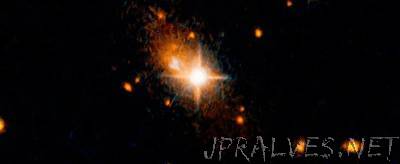
“Though several other suspected runaway black holes have been seen elsewhere, none has so far been confirmed. Now astronomers using the NASA/ESA Hubble Space Telescope have detected a supermassive black hole, with a mass of one billion times the Sun’s, being kicked out of its parent galaxy. “We estimate that it took the equivalent energy of 100 million supernovae exploding simultaneously to jettison the black hole,” describes Stefano Bianchi, co-author of the study, from the Roma Tre University, Italy. The images taken by Hubble provided the first clue that the galaxy, named 3C186, was unusual. The images of the galaxy, located 8 billion light-years away, revealed a bright quasar, the energetic signature of an active black hole, located far from the galactic core. “Black holes reside in the centres of galaxies, so it’s unusual to see a quasar not in the centre,” recalls team leader Marco Chiaberge, ESA-AURA researcher at the Space Telescope Science Institute, USA.”
